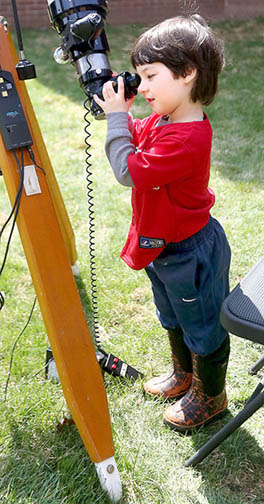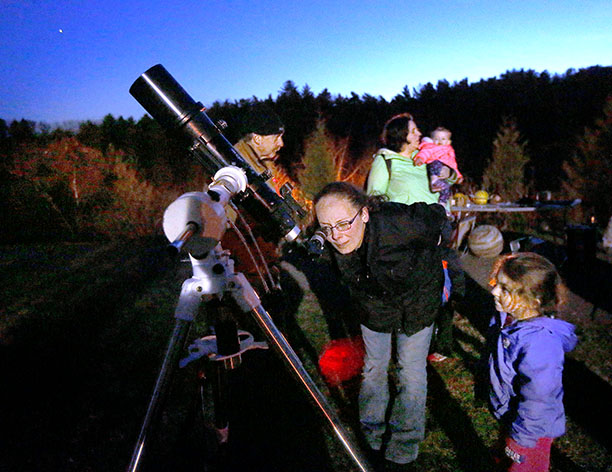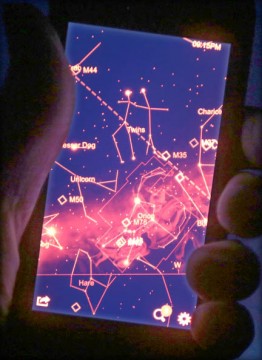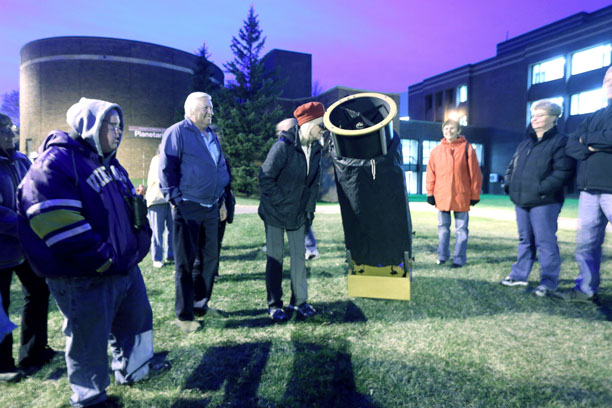Planning a sidewalk stargazing event? Here are a few suggestions to make sure people walk away smiling.

Bob King
I've taught community education astronomy in Duluth, Minnesota, for years and continue to be amazed at how stalwart people are when it comes to waiting their turn at the telescope on chilly nights. We always go out to observe after class no matter the weather, provided the sky is clear.
But resistance to cold or tolerance for mosquitoes only goes so far. Even Duluth skywatchers have their breaking point, so it's important to key in on bright, showy objects that easily reveal their charms to neophyte observers. For this reason I always chose the largest scope for the job to make the faint stuff as bright and easy to see as possible.
My job is an easy one if the Moon or a bright planet lights up the sky. In that case, it doesn't hurt to brush up on the names and sizes of prominent craters and other interesting lunar facts in advance. If you do your homework, you can impart a few essential nuggets of information to help those in line make the most of their minute at the eyepiece.
Only a minute? It seems much too short a time, but most people only gaze at an astronomical object for about 20 seconds, barely enough time to see anything! Whether it's out of politeness for the next in line, a brief attention span or something else, I always encourage people to take a minute and soak in the view as they might a painting by Picasso. Once they see the boldest features like Jupiter's two "stripes," I'll challenge them to the Great Red Spot (if present) or ask if they can tell that the planet is out of round.
Every detail visible becomes a learning opportunity involving the real thing rather than an image on a PowerPoint presentation. Just be careful to not go textbook on your audience. Leave them with a couple key concepts they'll remember and keep that line moving.

Bob King
Point to the Planets
When it comes to planets, if Jupiter or Saturn are visible, you're in luck. Saturn's rings never fail to amaze and newcomers love seeing the moons of both. It's a good idea to check beforehand with Sky & Telescope's Jupiter's Moons and Saturn's Moons to sort which moon is which. When you can name them, those little points of light become real places.
Venus and Mercury delight with their phases. Since Uranus and Neptune present so few details, I play a little game of guess-the-planet's-color. We compare notes and then discuss how atmospheric gases affect these planets' appearance.

Paul Maxson
Mars is almost always too small to see very much, but it retains an allure that overcomes its visual deficiencies. Even in so-so seeing, no one ever seems disappointed to get their first look at the Red Planet. With opposition less than a month away, and Saturn's to follow in early June, a telescopic visit to all three would make a perfect opportunity for a public gathering. Throw in a crescent or half Moon, and you'll have your hands full.
Go Clubbing
Although I've done many solo astro outings, club events add an extra dimension of fun as well as take the pressure off a single observer. Each scope can specialize on a particular object, allowing attendees to get a taste of each without having to wait for everyone to see the one object before moving on to the next.
Often, while the line works its way past the eyepiece, I'll pull out a green laser and point out the brighter constellations. Once people start looking up, all those eyes catch many things that one set can easily miss. I get great satisfaction when someone shouts out that they've sighted a satellite, a meteor, or the start of a northern lights display. People love finding things on their own. Indeed this is how so many of us made our own first connection to the night sky. Discovery. It's potent stuff, so be sure to spend part of every observing session just looking up with the group.

Bob King
After they get a taste of old-fashioned constellation hunting, surprise them by popping out your phone and demonstrating the power of some of the new sky apps for finding planets, stars and satellites. Many are free. I've listed a couple examples at the end of the article.
Some in your group will have to leave early. Always thank them for coming and make sure to give them a slip of paper with the names of both an Android and iPhone night sky / stargazing app and the websites where they can be downloaded. Of course, you will have thought of this in advance and have them ready for all your guests. Since nearly everyone has a smartphone, they can use the app to continue the journey of self-discovery on their own.
Proper Prep Makes the Star Party
Like I said earlier, when the planets and Moon are out, our job as night-sky tour guides is ever so much easier. Since that's not always the case, it's best to prepare a cosmic sampler that includes a bright representative of each major class of deep-sky object: open cluster, globular cluster, nebula, double star, and galaxy high enough in the sky for a great view. To that end, I've prepared two lists you might find helpful, one for the current season and another for summer.
If a bright gibbous or full Moon is out, I limit the session to the Moon, bright double stars, and bright open clusters. No sense explaining what they should be seeing when it's swamped by moonlight!
Your choices may (and probably will!) only partially overlap mine. Take these as a starting point:
Spring Season
- Planet: Jupiter is beautifully placed for viewing all this spring. #1 on the list! Be alert for shadow transits and eclipses of its moons that may occur during your outing. The shadows of Ganymede, Io, and Callisto are easiest to see for beginners.
- Open cluster: M35 in Gemini / M37 in Auriga in early spring. Late spring, try M67 in Cancer.
- Nebula: NGC 2392, a planetary nebula in Gemini. Great to use as a crystal ball to gaze into the Sun's far future.
- Globular cluster: M3 in Canes Venatici. I use low power for many objects but not globulars. For impact, 150×-200× is best.
- Double star: either Mizar-Alcor in the Big Dipper / Alpha (Cor Caroli) in Canes Venatici / Iota Cancri.
- Red star: Star colors are often pale but certain carbon stars have striking, smoky red hues. These little gems always elicit "wows!" Try V Hydrae (currently ~8.6 magnitude). Click for a chart.
- Galaxy: M51, the Whirlpool. One of the few galaxies that when high enough and viewed in a 10-inch or larger telescope reveals hints of spiral structure to a beginner. The M81–82 duo in UMa makes a great low-power pair that sweetly illustrates the difference between open and edge-on galaxies. If you're just looking for just a single bright galaxy, stop by either M94 (magnitude +8.9) or M63 (+9.3), both in Canes Venatici and easy to find. Their concentrated cores stands out well against their outer disks, making either a good choice for explaining basic galactic structure.

Bob King
Summer Season
- Planets: Take your pick — Jupiter, Mars and Saturn! Jupiter will leave the scene in July.
- Open cluster: M11, the Wild Duck Cluster.
- Nebula: M57, the Ring Nebula / M8, the Lagoon Nebula in Sagittarius, or the Veil Nebula in Cygnus. Use a nebular filter on both the Veil and M8 to enhance contrast and detail.
- Globular cluster: M13, the Great Globular in Hercules / M22 in Sagittarius / M5 in Serpens
- Double star: Beta Cygni (Albireo) / Beta Scorpii / Epsilon-1 and Epsilon-2 Lyrae, the "Double Double"
- Red star: T Lyrae. Click for a chart.
- Galaxy: M106 in UMa. Bright and big!
Always check for passes of the International Space Station (ISS) either at NASA's Spotthestation or on Heavens Above. Beginning skywatchers are delighted to know they can see the space station so easily. Watching it glide across the sky or suddenly disappear into Earth's shadow elicits a certain primal excitement.
Finally, when everyone else has gone home, a small, hardcore group will often remain. For these folks I keep an expanded list that includes more challenging objects: a bright quasar such as 3C273, currently well-placed in Virgo, additional galaxies, a planetary nebula, a close double star, and perhaps a comet.
When someone utters "wow!" at their first sight of a star cluster, I'm always reminded that sharing the sky works both ways. We help our guests expand their cosmic perspective, they help us enlarge our human one.
Resources
* Star Chart for Android — Free
* Star Chart for iPhone — Free
* Inexpensive and reliable green laser pointers
 12
12









Comments
Anthony Barreiro
April 27, 2016 at 7:16 pm
Thanks Bob, this is an excellent guide! I'm going to share this on my astronomy club's facebook page.
You must be logged in to post a comment.
Bob KingPost Author
April 28, 2016 at 9:45 am
Thank you, Tony. I'm glad you found it useful.
You must be logged in to post a comment.
PVirden
May 11, 2020 at 10:23 am
Thanks for an informative article!
My love for astronomy began when adults taught me at the age of 4 how to properly look through a telescope. As a result, I experienced the awe and wonder of seeing for the first time Mars & the Moon.
I am 70 now and have held many stargazing sessions for the public. I've seen many adults cause more issues than with young people! To see children express that incredible joy and magic with the night sky is fantastic. We need more, not less, children at our stargazing sessions.
You must be logged in to post a comment.
Jonathan -Hansen
April 29, 2016 at 8:26 pm
Having done many years of Sidewalk Astronomy here in California I find your summery here a very good starter...
But your first photo fills me with with horror!! A small child GRABBING the telescope!! Anyone who has ever done Sidwalk Astronomy knows what I'm talking about. Preschool age children will enviably grab the eyepiece, the focuser, or the telescope itself, and lean their body weight on the scope to move the object you had lined up totally out of alignment. Doesn't matter if it's a Dob or a GEM mounted Refractor. You have to stop and realign the scope.
Parents will push their preschoolers in line, who have no concept of what we are showing them. I use a ladder with a guard rail next to the eyepiece. Anytime I see a preschoolers I constantly have to be saying "Grab the Rail! Don't Touch the Scope"! Even that doesn't always work.
I much prefer areas that are predominately adult, to those which a lot of small children will be passing through. Because I like having intelligent conversations, to loudly shouting at some kid "Don't Touch the Telescope"!!
You must be logged in to post a comment.
Bob KingPost Author
May 1, 2016 at 7:23 pm
Hi Jonathan,
You're right - kids intuitively reach for the eyepiece, and most of the time we'll catch and caution them before it happens. But once in a while, they're too quick! Since most of the targets are bright and easy to reacquire I don't mind. If you do a line with a lot of kids at the scope, it might be a good idea to go up and down the line on occasion to let the parents (and kids) know not to touch, just to look. Having parents reinforce the message can help.
You must be logged in to post a comment.
Jeff Setzer
May 2, 2016 at 1:20 pm
Wonderful article, Bob! I like the modern advice of leveraging the nearly ubiquitous smartphone. One thing I've done a lot at public events is encourage people to get a shot of the Moon through the telescope. If there's a lot of people I'll ask them to come back after everyone in the group has had a look, and I'll offer to take the pic for them to make it easier. Invariably they tweet about it, and I'm sure to tell them to mention our group. We've been getting some referrals that way 🙂
You must be logged in to post a comment.
Bob KingPost Author
May 2, 2016 at 7:52 pm
Hi Jeff,
Thanks! Excellent suggestion.
You must be logged in to post a comment.
MALFeller
May 2, 2016 at 5:47 pm
I have to say I am a little disappointed in all the negative comments about sharing the skies with children. I have run the Winter Star Party Young Astronomers Camp for years (children ages 5-15) and now do monthly star parties at my preschool for families with participants ranging in age from 2 to 80+. We typically have a group of about 30 participants and have gotten as large as 70 with just two of us running things. If amateur astronomy is going to grow, we need to be inspiring and educating our youth, not resenting them. We run three telescopes at a time with only two "real" astronomers at each star party. (We work with a 6" DOB, a 13" DOB and a 16" Dob. Sometimes we also bring the 85mm refractor.) One of the first things we do each year is pick a few families who are consistent attendees and enlist their help and teach them how to properly run a scope. We also put a step ladder with a handle on it that gives the kids a place to put their hands and/or I offer my hand to both adults and kids so they have something to grab. Most of the time, when they grab for an eyepiece it is because they are unsure in the dark setting. In my experience, there are just as many adults who grab the eyepiece as there are kids. Before you write off the little ones, please allow me to share a story that happened in my preschool classroom just today. We had made ringed planets out of styrofoam balls and CDs. A mom picked up her four-year-old son's planet, held it with the rings standing vertically and asked him which planet it was? He answered Uranus. She immediately started to correct him when I stopped her and asked him why he said it was Uranus. He answered immediately that it was spinning on its side and had rings. I smiled, took the planet from her, turned it so the rings were horizontal and asked him what planet it was now. He immediately answered Saturn. I asked him to explain the difference to his mom and he took her to a posted of the solar system and showed her the two planets. There will always be people of any age at a star party who don't listen to directions. When I want peaceful viewing we go out alone. When I want to inspire wonder, we go out prepared to teach and knowing we will have to repeat ourselves. When a family comes to us for advice on what scope to buy and then comes back with stories of what they are viewing in it, it is well worth the hassle of having to remind someone where they can and cannot touch the scope for the twentieth time.
You must be logged in to post a comment.
Bob KingPost Author
May 2, 2016 at 7:55 pm
MalFeller,
I loved your story about the boy and the rings. And your comments about allowing kids a little leeway - well said! Thanks!
You must be logged in to post a comment.
AnthonyM
March 11, 2017 at 11:32 am
Bob, this is a great guide, thank you for your efforts! I have a question about star party telescopes - Like the previous commenter MEL who runs a Star Party Young Astronomers Camp, I'm a science teacher at a school with an astronomy background interested in doing public star parties that will be open for young children too. Do you recommend Dobs over other scopes for this? We have funding for up to $5k for this, should we still concider basic scopes? Dobs? Goto scopes? I was looking at the smaller Orion goto Dobs as they can return to alignment by themselves if pushed intentionally or by accident - thoughts or suggestions? We have good skies in our area, for now, and can see Palomar from our location. Thanks!
You must be logged in to post a comment.
Kishan B
August 15, 2017 at 5:54 am
Thanks for a great article Mr.Bob !
Im from SEDS-India and we conduct star parties frequently. This article will do a great job in making them more fun and interesting!
You must be logged in to post a comment.
Bob KingPost Author
August 15, 2017 at 11:36 am
You're welcome, Kishan. Thanks!
You must be logged in to post a comment.
You must be logged in to post a comment.